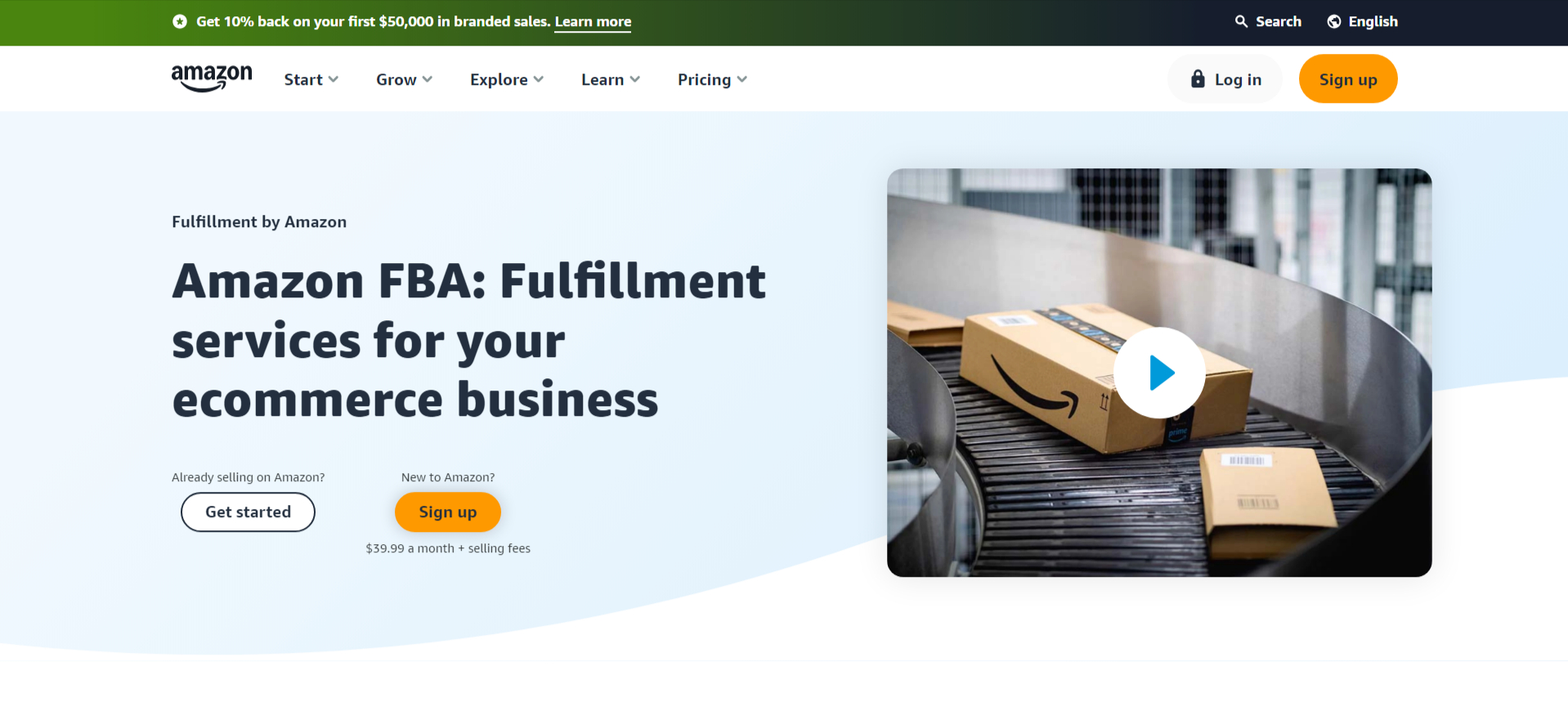Deciding where to sell products online can significantly impact the success of an e-commerce business. Shopify and Amazon are two of the most popular options, each offering unique benefits and challenges. Shopify provides retailers with full control over their brand and customization, while Amazon offers access to a massive marketplace with built-in customer trust. To choose the right platform, it’s essential to weigh these differences and understand how they align with your business goals.
[su_list class=”story-highlight”]Key Takeaways
- Shopify offers full control over branding and customization, while Amazon provides access to a vast marketplace with limited design flexibility.
- Shopify allows businesses to scale with customizable plans and third-party apps, while Amazon offers rapid sales growth but with intense competition and less brand control.
- Shopify supports detailed SEO customization for organic traffic, whereas Amazon’s internal algorithm prioritizes sales and customer behavior for product visibility.
- Shopify provides 24/7 support and extensive resources, while Amazon’s seller support is more limited, with fewer direct assistance options.
[/su_list]
Comparison Overview
| Feature | Shopify | Amazon |
| Brand Control | Full control over branding and customization. | Limited design flexibility, more uniformity. |
| Scalability | Flexible, customizable plans with third-party apps. | Rapid sales growth, but with intense competition. |
| SEO | Detailed SEO tools for organic traffic. | The internal algorithm prioritizes sales and reviews. |
| Support | 24/7 support, extensive resources, and community. | Limited seller support and fewer assistance options. |
| Marketplace Access | Independent store drives own traffic. | Built-in marketplace with a vast customer base. |
| Customization | Drag-and-drop editor, editable HTML/CSS. | Limited to Brand Registry for advanced features. |
| Third-Party Apps | Over 8,000 apps in the Shopify App Store. | Limited apps focused on enhancing listings. |
Platform Flexibility and Scalability
1. Shopify’s Customization Options
Shopify stands out when it comes to customization and flexibility. The platform offers a wide range of professionally designed templates, allowing sellers to create unique and visually appealing online stores. With over 80 themes, including free and premium options, Shopify makes it easy for businesses to establish a distinct brand identity.
One of Shopify’s key strengths is its user-friendly interface. The platform provides a drag-and-drop feature, making it simple for users with little to no coding experience to customize their storefronts. For those with more advanced skills, Shopify allows direct editing of HTML and CSS code, offering complete control over design and functionality.

Shopify’s customization options extend beyond aesthetics. The platform provides powerful tools for organizing products, optimizing SEO, and personalizing checkout. This level of flexibility enables businesses to create a seamless and branded shopping experience, leading to increased customer loyalty and higher conversion rates.
2. Amazon’s Marketplace Limitations
In contrast to Shopify, Amazon’s platform has more limitations when it comes to customization. As a marketplace, Amazon’s primary focus is on providing a consistent shopping experience across all sellers. This approach has its advantages, such as familiarity for customers, but it can make it challenging for individual sellers to stand out.
Amazon’s design options are relatively restricted. Sellers can upload their images and product descriptions, but the overall layout and design of store pages are controlled by Amazon. This uniformity can make it difficult for brands to differentiate themselves from competitors.
[su_service title=”Important” icon=”icon: exclamation-triangle” icon_color=”#00ae27″ size=”20″ class=”ImportntBox”]
While Amazon does offer some customization through its Brand Registry program, including the ability to create a brand storefront and use A+ Content, these options are still limited compared to Shopify’s extensive customization capabilities. Amazon’s templates are designed to be recognizable as part of the Amazon ecosystem, which can be beneficial for trust but may hinder unique brand expression.
[/su_service]
3. Growth Potential Comparison
When it comes to scalability, both Shopify and Amazon offer significant opportunities for growth, but in different ways.
Shopify provides a robust platform that can help your business grow. As your needs evolve, you can easily upgrade to higher-tier plans that offer more advanced features. Shopify’s app store, with thousands of integrations, allows businesses to add functionality as they scale, from inventory management to marketing tools.
Amazon, on the other hand, offers immediate access to a vast customer base. The platform’s enormous reach and established logistics network, particularly through Fulfillment by Amazon (FBA), can help businesses scale quickly in terms of sales volume. However, this growth potential comes with intense competition and less control over branding and customer relationships.

Ultimately, the choice between Shopify and Amazon for scalability depends on your business goals. Shopify offers more control and customization as you grow, while Amazon provides access to a larger market but with less flexibility in how you present your brand.
SEO and Discoverability
When it comes to getting products in front of potential customers, both Shopify and Amazon offer unique advantages.
1. Shopify’s SEO Tools
Shopify gives store owners a lot of control over their SEO strategy. The platform comes with built-in features that make it easier to optimize stores for search engines like Google. These include customizable title tags, meta descriptions, and automatically generated sitemaps. Shopify also provides an integrated blogging platform, which can be a powerful tool for creating SEO-optimized content to draw in organic traffic.
One of Shopify’s strengths is its flexibility. Store owners have full control over important on-page SEO elements like URLs, alt text, and heading tags. This level of customization allows businesses to target specific keywords and phrases effectively, potentially improving their rankings in search engine results pages.
Shopify also offers a range of apps and integrations that can further enhance SEO efforts. These tools can help with keyword research, content optimization, and tracking SEO performance. This comprehensive approach to SEO gives Shopify users the potential to drive organic traffic independently of any marketplace.
2. Amazon’s Search Algorithm
Amazon’s approach to SEO is quite different from Shopify’s. The platform uses its search algorithm, known as A9 (or more recently, A10), which focuses on optimizing product listings for Amazon’s internal search results rather than external search engines like Google.
The Amazon algorithm takes into account factors such as relevance, buyer intent, and sales history when ranking products. It places a significant emphasis on understanding what buyers are searching for and matching them with the most relevant products. This means that products aligned with specific search terms and user behavior are more likely to rank higher within Amazon’s ecosystem.
[su_service title=”Info” icon=”icon: info-circle” icon_color=”#000″ size=”20″ class=”InfoBox”]
One key aspect of Amazon’s algorithm is its focus on conversion rates and sales performance. Products that consistently sell well and have positive customer reviews tend to rank higher in search results. This can create a challenging cycle for new sellers, as products need visibility to generate sales, but they need sales to gain visibility.
[/su_service]
3. Product Visibility Comparison
When comparing product visibility on Shopify and Amazon, each has its strengths. Shopify offers more control over SEO, allowing businesses to optimize their entire site for better visibility in search results and attract early-stage buyers.
Amazon provides instant access to a massive customer base, but the competition is intense, making it harder to stand out, especially for new sellers. However, Amazon offers dual SEO opportunities, sellers can optimize listings for both Amazon’s internal search and external search engines like Google.
Ultimately, Shopify provides more customization and control, while Amazon offers immediate traffic but with higher competition and less control over branding.
Customer Support and Resources
When it comes to running an online business, having reliable support and resources is crucial. Both Shopify and Amazon offer assistance to their sellers, but the quality and extent of support differ significantly between the two platforms.
1. Shopify’s Help Center and Support
Shopify stands out with its comprehensive support system. The platform offers 24/7 customer support through various channels, including phone and live chat. This round-the-clock availability ensures that store owners can get help whenever they need it, regardless of their time zone or business hours.
In addition to direct support, Shopify provides an extensive Help Center filled with articles, tutorials, and guides. These resources cover a wide range of topics, from setting up a store to advanced marketing techniques. For those who prefer visual learning, Shopify also offers video tutorials to help users navigate the platform’s features.
One of Shopify’s unique offerings is its community forum. Here, merchants can ask questions and get help from other Shopify users, creating a collaborative environment for problem-solving and sharing best practices. For more specialized assistance, Shopify Experts are available for hire, providing professional help with store building, marketing, and management.
2. Amazon’s Seller Support
In contrast to Shopify, Amazon’s support for sellers is more limited. The e-commerce giant offers phone and chat support, but these services are only available during business hours on weekdays. This restricted availability can be challenging for sellers who operate outside of these hours or need urgent assistance.
Amazon does provide a ‘Seller University’ with tutorials and guides, which can be helpful for new sellers learning the ropes. However, the depth and breadth of these resources are not as extensive as Shopify’s offerings. Amazon also has seller forums where merchants can seek help from the community, but response times can be slow, and the quality of answers may vary.
3. Assistance Quality Comparison
When comparing Shopify and Amazon, Shopify stands out with superior customer service, a variety of support options, and an engaged user community. Its hands-on help and extensive learning materials make it ideal for new e-commerce entrepreneurs.
However, Shopify’s support can have slower response times, and the complexity of building a store may lead to unresolved issues. In contrast, Amazon’s support is more limited, but it is easier to sell quickly, though sellers often navigate challenges independently.
Ultimately, Shopify offers more comprehensive support, while Amazon suits those preferring a self-directed approach.
Integration and Third-Party Apps
1. Shopify App Store
Shopify’s App Store is a treasure trove of tools and integrations that can enhance various aspects of e-commerce businesses. With over 8,000 apps developed by trusted Shopify developers, store owners have access to a wide range of solutions for marketing, analytics, customer support, and more. This extensive selection allows businesses to customize their stores and add functionality as needed.
One standout app is Fabrikatör, an all-in-one solution for managing inventory, orders, and fulfillment. It enables real-time stock tracking, low-stock alerts, and comprehensive sales performance analysis. This tool can help Shopify users streamline their operations and make data-driven decisions to grow their business.

Another powerful integration is Polymer, a Business Intelligence platform that centralizes e-commerce data. It provides creative ways to present data through customizable dashboards, allowing for easy analysis and sharing of insights across an organization.
2. Amazon Seller Central Tools
Amazon offers its own set of tools within Seller Central to help merchants boost their product visibility and marketing efforts. These include Amazon Advertising, Sponsored Products, and the Brand Registry program. While not as extensive as Shopify’s app ecosystem, these tools are specifically designed to work within Amazon’s marketplace.
[su_service title=”Info” icon=”icon: info-circle” icon_color=”#000″ size=”20″ class=”InfoBox”]
The Seller Central App allows merchants to create coupons, obtain product reviews, and access Enhanced Brand Content. These features can help sellers stand out in Amazon’s competitive marketplace and improve their product listings.
[/su_service]
3. Ecosystem Comparison
Shopify’s ecosystem offers more flexibility and a wider range of third-party integrations, ideal for businesses seeking customization. However, many Shopify apps come with extra costs that can accumulate over time. In contrast, Amazon’s tools are usually included in its selling plan or have simpler fees.
Interestingly, Shopify and Amazon can be integrated using the Marketplace Connect app, allowing sellers to sync products, inventory, and orders between the two platforms. This setup provides the flexibility of Shopify with access to Amazon’s vast customer base.
Ultimately, Shopify offers more customization, while Amazon provides built-in tools and traffic. The choice depends on your business needs and strategy.
Read More:
- WooCommerce Vs. Shopify: What Is Better For Your Online Business?
- Harnessing the Power of Author Schema: Enhancing E-A-T with Structured Data
- How We Migrated This Website Without Impacting SEO
How Do You Choose Between Shopify and Amazon?
The choice between Shopify and Amazon has a significant impact on an e-commerce business’s growth and success. Both platforms offer unique advantages, with Shopify providing more control over branding and customization while Amazon offers access to a vast customer base. The decision ultimately depends on a business’s specific needs, resources, and long-term goals. Whether prioritizing flexibility or immediate market reach, entrepreneurs should carefully weigh the pros and cons of each platform.
In the end, many successful businesses find ways to leverage both platforms to maximize their online presence. By using Shopify for a branded storefront and Amazon as an additional sales channel, sellers can enjoy the best of both worlds. This approach allows businesses to maintain their unique identity while tapping into Amazon’s extensive customer network. As the e-commerce landscape continues to evolve, staying adaptable and open to different strategies will be key to thriving in this dynamic market.
Moiz Banoori is a Digital Marketing specialist with over eight years of experience in content creation and digital journalism. He leads teams at various brands and focuses on developing effective SEO strategies that enhance online visibility. With a degree in journalism, Moiz combines his passion for storytelling with technical skills to deliver innovative digital solutions at REDLUMB, helping clients achieve their online goals in a competitive landscape.





